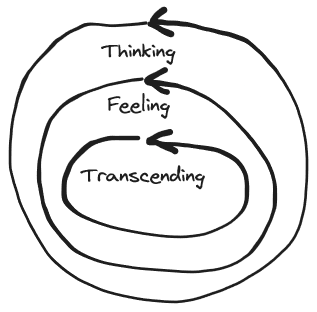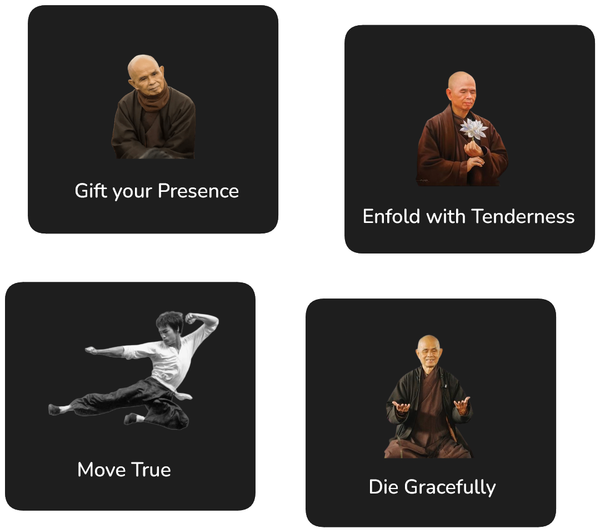Five Steps to Peace
Discover the path to inner peace with this enlightening article that outlines five transformative steps towards achieving a serene state of mind grounded in the teachings of Thich Nhat Hanh.

Life can be hectic and sometimes overwhelming, leaving us yearning for a sense of calm amidst the chaos. With so much going on around us and within our own thoughts, finding peace might seem like an impossible task. But what if I told you that inner tranquillity isn't as far out of reach as it may appear? In this article, I explore five straightforward steps that can guide you towards a more peaceful state of mind.
The five steps I propose are:
- Step 1: Understand That Suffering is Self-Imposed
- Step 2: Be a Curious, Detached Observer
- Step 3: Nourish the Wholesome, Accept the Harmful with Tenderness
- Step 4: Immerse Yourself in Direct, Unobstructed Experience
- Step 5: Allow God to Fill the Empty Spaces
These steps are grounded in the teachings of Thich Nhat Hanh and Anthony de Mello.
Step 1: Understand That Suffering Is Self-Imposed
The first step involves a fundamental shift in how we look at unpleasant feelings that emerge within us; such as fear, anxiety, worry or anger.
Usually, we are quick to blame others, our environment or other factors for our feelings. Which may give us some relieve but is ultimately misguided.
Some suffering like physical pain physical pain from touching a hot plate is immediate and unavoidable. However, worries about future events or regrets about past actions are often self-created burdens. We needn't carry these weights; they live only in our imagination.
Existential suffering—the kind where life seems devoid of meaning—is something we only inflict upon ourselves. No external force mandates this despair; it stems from within us. Acknowledging that much of our suffering is self-imposed is the first step towards liberation from it.
Reality is not upsetting. Reality is not problematic. If there were no human mind, there would be no problems. All problems exist in the human mind. All problems are created by the mind.
— Anthony De Mello - Rediscovering Life: Awaken to Reality
Step 2: Be a Curious, Detached Observer
The second step on our journey to peace involves engaging our mind with the insight that attachment is often the root of suffering.
Consider the attachments in your life. Perhaps you're attached to others perceiving you positively; when you recall an embarrassing moment from your past, it's this attachment to your desired image that causes regret and suffering. Similarly, if you take pride in your appearance, the natural changes that come with ageing might lead to sadness when your beauty fades. Or maybe the loss of money distresses you because of your attachment to financial security.
To reduce suffering, we must learn to untangle ourselves from these attachments.
Observation is key for achieving this. It helps us understand our suffering better and overcome it. When we understand our emotions, they no longer control us; instead, we gain control over them.
Herein, it's also crucial that we refrain from judgment during observation. Judging ourselves harshly can lead to a negative spiral of self-criticism and increased suffering. For example, calling yourself lazy for not completing a task only reinforces that negative self-image and hinders progress.
By observing without judgment—simply seeking to understand—we can see reality more clearly. This clarity empowers us to make the necessary changes in our lives without being hindered by distorted perceptions or harsh self-criticism.
In summary, becoming a curious, detached observer allows us to see our attachments for what they are—the source of much of our suffering—and provides us with the insight needed to move towards peace.
Step 3: Nourish the Wholesome, Accept the Harmful with Tenderness
The third step in our journey towards peace takes us deeper into the realm of our emotions, where we learn to cultivate what nourishes us and tenderly accept what does not. Thich Nhat Hanh, a revered Buddhist monk, taught that what we choose to nurture within it that can lead to suffering or well-being. He said, "There is nothing wrong in having consciousness. It is only when we water unwholesome seeds — ignorance, hatred, jealousy, anxiety — that consciousness causes suffering to ourselves and others."
Some seeds grow into beautiful flowers of joy and compassion if we water them; others turn into thorny bushes of resentment and fear if given attention. Our task is to nourish those seeds that bring about positive emotions—what Buddhists refer to as 'wholesome mental formations'—such as joy, compassion, equanimity, and loving-kindness.
When you encounter these positive feelings, indulge in them. Let them fill you with energy and strength. These are not merely transient good feelings but deep-seated states that enrich your spirit and provide wholesome energy.
However, feeling good isn't always synonymous with wholesomeness. For instance, schadenfreude—the pleasure derived from another person's misfortune—is a feeling that might momentarily feel satisfying but ultimately sows seeds of negativity within us. It's crucial to discern between feelings that truly nourish us and those that offer fleeting gratification at the expense of our inner peace.
At the same time, it's important not to reject or admonish ourselves for experiencing negative emotions. Instead, we should accept them with tenderness. Thich Nhat Hanh advised treating these feelings like an innocent child; rather than scolding or suppressing them—observe them with compassion as a loving mother would her child.
Thich Nhat Hanh also taught that without suffering there can be no joy—the two are interdependent. The worst kind of hell he could imagine would be one devoid of suffering because it would also lack joy. This perspective helps us understand that negative emotions have their place; they are part of the human experience and can drive us towards greater appreciation for the positive aspects of life.
In summary, step three encourages us to indulge in wholesome feelings while accepting harmful ones with tenderness—not as something to detest and judge but as a natural contrast enabling us to cherish joy all the more deeply. This balance between nurturing positivity and accepting negativity without judgment sets the stage for profound inner peace.
Step 4: Immerse Yourself in Direct, Unobstructed Experience
The fourth step towards peace is about immersing ourselves in the raw beauty of the present moment. It's about engaging directly with the world around us, without the filters of our preoccupations and worries. Buddhism emphasises mindfulness as a means to experience life fully. Many practices involve focusing our attention on simple experiences—what we see, hear, smell, taste—and truly getting lost in them.
Take a meal, for instance. When you take a bite, focus intently on the flavours dancing on your tongue. What are the textures and tastes that unfold? Similarly, when you look at your surroundings, notice the shapes and colours that you see.
He looked around, as if he was seeing the world for the first time. Beautiful was the world, colourful was the world, strange and mysterious was the world! Here was blue, here was yellow, here was green, the sky and the river flowed, the forest and the mountains were rigid, all of it was beautiful, all of it was mysterious and magical, and in its midst was he, Siddhartha, the awakening one, on the path to himself.
— Herman Hesse - Siddhartha
We often overlook these simple pleasures because we're too busy with other things. There's a poignant truth in the saying often attributed to John Lennon: "Life is what happens to you while you're busy making other plans." Life is indeed nothing but this very moment—the here and now that we can experience through our senses.
Marcus Aurelius reminds us that "[y]ou can’t lose either the past or the future; how could you lose what you don’t have?" This wisdom underscores that only the present is tangible and real; everything else exists only as thoughts in our minds.
To find peace and joy, we need not embark on grand adventures across the globe; beauty abounds right where we are. The challenge lies in removing mental obstructions—our distracted thoughts, worries, anxieties—and allowing ourselves to see clearly.
There's another saying that resonates with this idea: "If the eye is unobstructed, it results in sight; if the ear is unobstructed, the result is hearing; if the nose is unobstructed, the result is a sense of smell; if the mouth is unobstructed, the result is a sense of taste; if the mind is unobstructed, the result is wisdom." This ties back to earlier steps where detachment from judgment and emotional burdens allows us to experience life more fully.
By focusing on direct experiences without distraction or judgment, we open ourselves up to a world of wonder that has always been there but often goes unnoticed. It's through this mindful engagement with our environment that we can encounter profound truths about life and find deep contentment within ourselves.
In essence, step four encourages us to embrace life's simple pleasures by being fully present in each moment. By doing so, we allow ourselves to connect with peace through direct experience—the kind of peace that comes from within and radiates outward into every aspect of our lives.
Step 5: Allow God to Fill the Empty Spaces
As we ascend the steps towards peace, each one takes us closer to a profound tranquillity that seems just beyond our grasp. The initial steps, centred on understanding and observing our minds, lay the groundwork but do not in themselves bring peace. They are merely signposts pointing towards a deeper journey within. As we progress through nurturing wholesome emotions and engaging with direct experiences, we edge nearer to the realm of true peace and joy.
Yet, even these steps, as transformative as they are, fall short of delivering ultimate peace—the kind that answers life's most piercing question: "Why are we here?" It is in this quest for ultimate meaning that many turn towards the divine or a higher power. But what is this 'God' or higher power? It's not an entity easily defined by human language or confined within our limited understanding.
It is agreed by many philosophers that we cannot define God, nor are we able to lay out a path that guarantees to find the divine. Thomas Aquinas argued many centuries ago that God is beyond definition; we can only speak of what divinity is not rather than what divinity is.
About God, we can say this much with certainty: That we do not know what He is.
— Thomas Aquinas
In this final step towards peace, we are encouraged to create spaces empty of thought—a silence from which divinity can emerge. By emptying ourselves of preconceptions and allowing our minds to become still waters, we open up to an experience beyond words or thoughts—an encounter with something sacred that fills the voids within us.
Then I knew that awareness is how the human being experiences the light of consciousness. I learned the meaning of attention--it is the intentional channeling of awareness. I felt my body again, as a hollow vessel. I looked at my legs; they filled with warm, radiant light, disappearing into brightness. I looked at my arms, with the same result. I focused attention on every part of the body, until I became wholly light once again. Finally, I realized the process of real meditation to expand awareness, to direct attention, to ultimately surrender to the Light of Consciousness.
— Dan Millman
This step isn't about seeking God in a traditional sense but rather about creating a space where something transcendent might be found. It's about reaching a state where there is no 'self' left—only pure being. In this emptiness, free from the cacophony of mental noise, what some may call God can make itself known.
It's important to approach this step without expectation or desire for certainty and proof; it’s an invitation to explore without attachment to outcome. As you allow yourself to become nothing more than presence itself—just being—you may find that in these moments of profound emptiness and silence something ineffable touches your spirit.
This encounter cannot be prescribed or detailed; it must be experienced personally. And so I invite you: try it for yourself. Sit quietly after moving through the previous four steps; let go of thoughts and simply exist in stillness. If nothing happens at first, be patient—the divine often whispers before it sings.
In embracing emptiness and surrendering fully to the moment, you may just find that ultimate peace emerges naturally from within—a peace not dependent on answers but grounded in an inexplicable connection with all that is.
Remember these words as you seek out this final step:
When the self dies all problems die with it. Where the self is not. Love is. God is.
— Anthony De Mello
And so concludes our journey through five steps to finding peace in a troubled world—a path inward toward serenity where each step builds upon the last until finally, we stand at the threshold of divinity itself—not defined by human constructs but felt deeply within our own being.
Conclusion
As we navigate through the steps outlined in this article, it's important to understand that they are not merely sequential checkpoints but interconnected facets of a holistic process. Embarking on the journey towards peace is not a linear path but rather a dynamic cycle of awareness, where each aspect of our being—mind, body, and soul—plays an integral role.

— Cycle of Awareness
The outer layer of this cycle involves our thinking mind—the place where we reflect and gain insights. Our conscious thought is within our control—it's the engine of change that we can harness, albeit not an overwhelmingly powerful one. Here, we confront the self-imposed nature of much of our suffering. By understanding that many of our problems stem from within, we can begin to dismantle the illusions that bind us to unhappiness. Thich Nhat Hanh's teachings remind us that our environment can influence which seeds in our consciousness grow and which wither away.
As we move inward towards the middle layer, we encounter our emotions and physical sensations. It is here that we cultivate feelings like love, joy, compassion, and equanimity—states that bring us closer to peace by freeing our minds. These emotions act as conduits through which we can experience life more deeply and connect with the raw unobstructed experiences of our senses.
At the core lies the centre of deep awareness and transcendence—the soul's domain where shallow awareness gives way to profound connection. In this sacred space, devoid of thought or judgment, one may encounter what some call God—a presence beyond words or comprehension. This divine essence fills the empty spaces within us when we surrender fully to stillness.
The cycle of awareness is not simply about acquiring more knowledge but oscillating between knowing and unknowing—between engaging with thoughts and letting go to simply be in direct experience.
In conclusion, peace is not a destination but an ever-present potential within each moment—a dance between thought, feeling, sensation, and spiritual connection. By embracing the proposed steps and the cycle of awareness with openness and patience, one can live in harmony with both inner tranquillity and the world at large.





